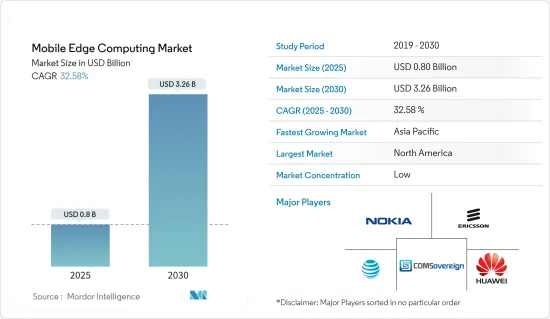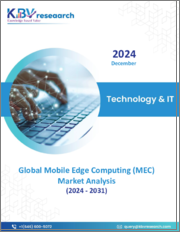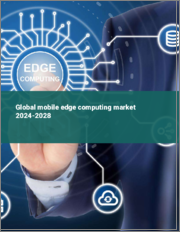
|
시장보고서
상품코드
1687939
모바일 엣지 컴퓨팅 - 시장 점유율 분석, 산업 동향 및 통계, 성장 예측(2025-2030년)Mobile Edge Computing - Market Share Analysis, Industry Trends & Statistics, Growth Forecasts (2025 - 2030) |
||||||
모바일 엣지 컴퓨팅 시장 규모는 2025년에 8억 달러에 달하고, 2030년에는 32억 6,000만 달러에 이를 것으로 예상되며, 예측 기간 중(2025-2030년) CAGR은 32.58%를 나타낼 것으로 전망됩니다.

모바일 엣지 컴퓨팅으로 일반적으로 알려진 멀티 액세스 엣지 컴퓨팅(MEC)은 엣지 컴퓨팅의 한 형태로 클라우드 컴퓨팅을 네트워크 엣지에 도입하여 기능을 향상시킵니다. MEC는 ETSI(European Communication Standardization Organization) 프로그램의 성과였으며, 처음에는 모바일 네트워크에 엣지 노드를 배치하는 것을 목표로 했지만, 이후 고정(또는 결국 통합) 네트워크로 확장되었습니다. MEC는 사용자나 장치에서 멀리 떨어진 서버에서 수행되는 기존 클라우드 컴퓨팅과는 대조적으로 네트워크의 기지국, 중앙 사무실 및 기타 집계 사이트에서 작동할 수 있습니다.
주요 하이라이트
- 디지털 미디어 서비스에 대한 수요는 무선 계약의 수가 급격히 증가함에 따라 모바일 무선 네트워크가 급격히 발전하고 있습니다. 따라서 새로운 수준의 성능과 생산성을 추진하기 시작했습니다. 기존의 데이터 관리와 분석은 클라우드와 데이터센터에서 이루어졌습니다.
- 게다가, 현재의 4G 네트워크가 한계에 도달하고 있기 때문에 5G에서는 온라인 트래픽을 훨씬 지능적으로 관리할 필요가 있어, 모바일 엣지 컴퓨팅이 큰 역할을 하게 됩니다.
- 통신 산업에서 엣지 컴퓨팅(모바일 엣지 컴퓨팅, MEC, 멀티 액세스 엣지 컴퓨팅이라고도 함)은 최종 사용자와 가까운 곳에서 네트워킹을 수행하는 용도에 실행 리소스(컴퓨팅 및 스트레이 지)를 제공하는 것으로, 많은 경우, 통신 사업자 네트워크의 내부 또는 경계에서 행해집니다.
- 다른 네트워크 기술/아키텍처와 마찬가지로 MEC는 보안 프레임 워크가 없기 때문에 다양한 위협과 하드웨어 위협에 노출되기 쉽습니다.
모바일 엣지 컴퓨팅 시장 동향
최종 사용자 산업에서 5G 및 산업용 IoT 서비스의 용도 증가
- 사물인터넷(IoT) 무브먼트를 원동력으로 하는 인더스트리 4.0은 다양한 기술 플랫폼을 상호 연결하여 세계 어느 곳에서나 세계 어디에서나 제조 장비와 인터페이스할 수 있는 능력을 기재하고 있습니다. - 4.0이 산업을 변혁해, 레거시 시스템으로부터 스마트 컴퍼넌트나 스마트 머신에, 디지털 공장의 촉진이나 접속된 공장이나 기업의 에코시스템의 개발로 발전하는 가운데, MEC 플랫폼은 흥미로운 전개의 기회를 찾아냅니다.
- 산업 자동화의 IoT는 5G 서비스에서 최대한의 혜택을 받을 것으로 예상됩니다.
- 의료산업에서는 IoT를 통해 공급자는 커넥티드 메디컬 솔루션을 통해 환자의 건강을 원격 모니터링할 수 있게 되어 실시간 데이터 수집 및 실시간 모니터링 및 분석에 대한 확대 액세스도 가능하게 됩니다. Corporation은 스마트 환자 케어, 5G를 활용한 혁신적인 의료 행위 개발, 병원 운영 효율 개선을 위해 제휴했다고 발표했습니다.
- 에너지 유틸리티 회사는 5G를 둘러싼 비즈니스 케이스, 서비스, 파트너십의 적극적인 개선으로 견인 역할을 하고 있습니다. 회사는 스마트시티가 1,000억 달러의 유틸리티 수익을 창출할 것으로 예측했습니다.
북미가 큰 점유율을 차지할 전망
- 북미에는 세 가지 주요 클라우드 서비스 제공업체가 있습니다. Amazon Web Services, Microsoft Azure, Google Cloud입니다. Inc. 등, 모바일 엣지 컴퓨팅 시장의 주요 공급업체가 진출하고 있어, 이 지역의 모바일 엣지 컴퓨팅 시장에 플러스의 영향을 주고 있습니다.또 이 지역은 5G, 자율 주행, IoT, 블록 체인, 게임, AI 등, 모든 주요한 기술 혁신의 거점이라고도 생각되고 있습니다.
- 미국과 캐나다와 같은 국가는 신기술을 신속하게 채택하는 것으로 알려져 있습니다. 현재 대부분의 신기술은 데이터 집약적입니다. 현재, 새롭게 생성되고 사용되는 데이터의 양은 이러한 인프라가 고객의 요구를 지원할 수 없습니다고 생각됩니다.
- 대부분의 기업은 실시간 데이터 액세스와 처리에 의존하기 때문에 대기 시간이 낮을수록 전체 프로세스가 중단될 수 있습니다.
- 게다가 모바일 엣지 컴퓨팅에 의해 다양한 부문의 소비자나 기업이 데이터센터의 파워를 거의 실시간으로 활용할 수 있게 되어, 홈 엔터테인먼트나 게임으로부터 의료나 농업까지, 모든 부문의 변혁 기술을 뒷받침하는 고속·저지연 모바일 네트워크의 가능성이 한층 더 넓어집니다.
- 이 지역의 다양한 최종 사용자는 5G, IoT, 모바일 엣지 컴퓨팅 등의 첨단 기술과 결합한 혁신적인 플랫폼을 개발하기 위해 엣지 컴퓨팅 공급자와의 파트너십을 깊게 하고 있습니다. 생명을 구하는 의료 기술 플랫폼입니다. 5G, IoT, 엣지 컴퓨팅 등의 기술과 Proximie의 세계 최고 수준의 커넥티드 수술 케어 소프트웨어를 조합하여 의료 전문가는 세계의 수술실에서 가상적으로 「스크럽 인」, 「기록」, 「대화」를 실시할 수 있게 되어, 인재 육성의 신속화와 개선, 질 높은 수술 케어의 효율적인 제공을 대규모로 지원할 수 있게 됩니다.
모바일 엣지 컴퓨팅 산업 개요
모바일 엣지 컴퓨팅 시장은 여러 세계 기업과 지역 기업으로 구성되어 상당히 경쟁이 치열한 시장 공간에서 주목을 받으려고 합니다.
- 2022년 9월 노키아는 온프레미스 미션 크리티컬 인더스트리얼 엣지(MXIE) 컴퓨팅 솔루션의 새로운 플랫폼 기능과 용도를 발표했습니다.
- 2022년 9월, Verizon은 미국군과 제휴하여 Joint Base Pearl Harbor Hickam(JBPHH)의 항공기 정비 격납고 내에 프라이빗 5G 네트워크를 구축했습니다.
기타 혜택
- 엑셀 형식 시장 예측(ME) 시트
- 3개월간의 애널리스트 서포트
목차
제1장 서론
- 조사의 전제조건과 시장 정의
- 조사 범위
제2장 조사 방법
제3장 주요 요약
제4장 시장 인사이트
- 시장 개요
- 산업의 매력 - Porter's Five Forces 분석
- 공급기업의 협상력
- 구매자의 협상력
- 신규 진입업자의 위협
- 대체품의 위협
- 경쟁의 강도
- 밸류체인 분석
- COVID-19가 모바일 엣지 컴퓨팅 시장에 미치는 영향
제5장 시장 역학
- 시장 성장 촉진요인
- 지연에 특화된 용도의 보급과 성장
- 최종 사용자 산업에서 5G와 산업용 IoT 서비스의 적용 확대
- 시장 성장 억제요인
- 공통 보안 프레임워크 부족
제6장 시장 세분화
- 구성 요소별
- 하드웨어
- 소프트웨어
- 최종 사용자별
- 금융 및 은행 산업
- 소매
- 의료 및 생명과학
- 산업
- 에너지 및 유틸리티
- 통신
- 기타
- 지역별
- 북미
- 유럽
- 아시아
- 호주 및 뉴질랜드
- 라틴아메리카
- 중동 및 아프리카
제7장 경쟁 구도
- 기업 프로파일
- Nokia Corporation
- Telefonaktiebolaget LM Ericsson
- Comsovereign Holding Corp
- AT& T Inc.
- Huawei Technologies Co. Ltd.
- Verizon Communication Ltd
- SGH, Inc.(penguin Solutions)
- ADLINK Technology Inc.
- Vodafone Group PLC
- Adva Optical Networking SE
제8장 투자 분석
제9장 시장 기회와 앞으로의 동향
KTH 25.05.12The Mobile Edge Computing Market size is estimated at USD 0.80 billion in 2025, and is expected to reach USD 3.26 billion by 2030, at a CAGR of 32.58% during the forecast period (2025-2030).

Multi-access edge computing (MEC), popularly known as mobile edge computing, is a form of edge computing that brings cloud computing to the network's edge to increase its functionality. MEC is a result of the European Telecommunications Standards Institute (ETSI) program that was first intended to place edge nodes on mobile networks but has since expanded to include the fixed (or eventually integrated) network. MEC permits operations in base stations, central offices, and other aggregation sites on the network, as opposed to traditional cloud computing, which takes place on distant servers, far from the user and device.
Key Highlights
- The demand for digital media services is increasing as the number of wireless subscriptions grows exponentially. Mobile wireless networks have advanced tremendously to meet this growing need. Enterprises across industries are beginning to drive new levels of performance and productivity by deploying different technological innovations, like sensors and other data-producing and collecting devices, along with analysis tools. Traditionally, data management and analysis are performed in the cloud or data centers. However, the scenario seems to be changing with the increasing penetration of network-related technologies and initiatives, such as smart manufacturing and smart cities.
- Furthermore, with the current 4G networks reaching their maximum limit, 5G will have to manage online traffic far more intelligently, in which mobile edge computing will play a major role. In addition to managing the data load, MEC is expected to significantly reduce the latency in 5G networks.
- In the telecom industry, edge computing, also known as mobile edge computing, MEC, or multi-access edge computing, offers execution resources (compute and storage) for applications with networking close to end users, often within or at the boundary of operator networks. Edge solutions offer key advantages: low latency, high bandwidth, device processing, data offloading, and reliable computing and storage.
- As with any network technology/ architecture, MEC is prone to various threats and hardware that lay in wait owing to its lack of security framework. A wide variety of threats and hazards could potentially occur in the MEC network. However, the most common attacks that hinder the market's growth can be narrowed down to compromised protocols, falsified information and logs, loss of policy enforcement, man-in-the-middle, and data loss.
Mobile Edge Computing (MEC) Market Trends
Rising Application of 5G and Industrial IoT Services Among End-user Industries
- Industry 4.0, powered by the Internet of Things (IoT) movement, involves interconnecting various technological platforms and presents the ability to interface with manufacturing equipment located anywhere in the world, from anywhere in the world. With Industry 4.0 transforming industries, from legacy systems to smart components and machines to facilitating digital factories and developing an ecosystem of connected plants and enterprises, MEC platforms find exciting opportunities for deployment.
- IoT in industrial automation is expected to derive maximum benefit from 5G services. The functionality to support this segment is currently being defined in 3GPP, influenced by Industry 4.0 initiatives and industry bodies, such as 5G-ACIA. It will be a 5G-specific segment for local area use cases and private network deployments.
- In the healthcare industry, IoT enables providers to monitor patient health remotely through connected medical solutions, along with real-time data collection and extended access to real-time monitoring and analysis. The healthcare sector is witnessing an increase in the deployment of 5G services. For instance, Samsung Medical Center and Korea's largest telecommunications company, KT Corporation, announced that they have partnered to develop smart patient care, 5G-powered innovative medical practices, and improve hospital operational efficiency.
- Energy and utility companies are driving the pack in actively improving business cases, services, and partnerships around 5G. According to Infosys, 56% of the energy and utility companies are defining use cases for 5G, and 20% have already established their 5G service portfolios along with the ecosystem partners. The company further anticipates that smart cities will create USD 100 billion in utility revenue. As electricity distributors manage poles and wires to all parts of the cities and neighborhoods, they could leverage their assets to offer smart surveillance solutions or smart lighting solutions to communities, law enforcement agencies, and enterprises.
North America is Expected to Hold Major Share
- North America is home to three major cloud service providers: Amazon Web Services, Microsoft Azure, and Google Cloud. In addition, the region is home to major mobile edge computing market vendors such as Verizon Communications Inc., AT&T Inc., etc., which positively impacts the mobile edge computing market in the region. This region is also considered to be the hub for all major technological innovations, such as 5G, autonomous driving, IoT, blockchain, gaming, and AI, among others.
- Countries like the United States and Canada are known to be early adopters of new technologies. Most new technologies at present are data intensive. They create, process, and transfer large amounts of data, due to which the current infrastructure, consisting of data centers and the cloud, is inching toward its maximum capacity. With the amount of new data generated and used presently, these infrastructures would not be able to support their customers' needs. Of all the parameters involved, latency is going to be the most crucial factor for business.
- Since most companies rely on real-time data access and processing, low latency can disrupt their entire process. This is where edge computing has helped infrastructure developers address the issue. With new technologies maturing, edge computing is expected to have a significant impact.
- Further, mobile edge computing allows consumers and businesses from various sectors to capitalize on the power of a data center in near real-time, unlocking the further potential for fast, low-latency mobile networks to empower transformative technologies for everything from home entertainment and gaming to healthcare and agriculture.
- Various end-users in the region are indulging in partnerships with edge computing providers to develop innovative platforms coupled with advanced technologies such as 5G, IoT, and mobile edge computing. For instance, in January 2022, Vodafone announced a partnership with Proximie, the health technology platform that digitizes operating rooms worldwide to save lives by sharing the world's best clinical practices. Combining technologies such as 5G, IoT, and Edge Computing with Proximie's world-class connected surgical care software, healthcare experts will be able to virtually' scrub in,' record, and interact with operating rooms across the world to help accelerate and improve workforce training and more efficient delivery of high-quality surgical care, at scale.
Mobile Edge Computing (MEC) Industry Overview
The MEC market comprises several global and regional players vying for attention in a fairly contested market space. However, the market is dominated by major vendors that cover a significant share of the market and compete to gain a foothold and become pioneers in different regional markets. Overall, the competitive rivalry among the vendors is expected to be high and remain the same during the forecast period.
- In September 2022, Nokia introduced new platform capabilities and applications for its on-premise Mission Critical Industrial Edge (MXIE) compute solution that would enable to host of applications from different ecosystems to advance enterprise digital transformation. It also developed vertical-specific blueprints that guide industrial enterprises to simplify their digital transformation.
- In September 2022, Verizon partnered with US Armed Forces to construct a private 5G network inside an aircraft maintenance hangar on Joint Base Pearl Harbor Hickam (JBPHH). With this design, it would be easy for military leaders to leverage the high-speed, high-bandwidth, and low latency of Verizon 5G.
Additional Benefits:
- The market estimate (ME) sheet in Excel format
- 3 months of analyst support
TABLE OF CONTENTS
1 INTRODUCTION
- 1.1 Study Assumptions and Market Definition
- 1.2 Scope of the Study
2 RESEARCH METHODOLOGY
3 EXECUTIVE SUMMARY
4 MARKET INSIGHTS
- 4.1 Market Overview
- 4.2 Industry Attractiveness - Porter's Five Forces Analysis
- 4.2.1 Bargaining Power of Suppliers
- 4.2.2 Bargaining Power of Buyers
- 4.2.3 Threat of New Entrants
- 4.2.4 Threat of Substitute Products
- 4.2.5 Intensity of Competitive Rivalry
- 4.3 Value Chain Analysis
- 4.4 Impact of COVID-19 on the Mobile Edge Computing Market
5 MARKET DYNAMICS
- 5.1 Market Drivers
- 5.1.1 Widespread Adoption and Growth of Latency-specific Applications
- 5.1.2 Rising Application of 5G & Industrial IoT Services Among End-user Industries
- 5.2 Market Restraints
- 5.2.1 Lack of a Common Security Framework
6 MARKET SEGMENTATION
- 6.1 By Component
- 6.1.1 Hardware
- 6.1.2 Software
- 6.2 By End-user
- 6.2.1 Financial and Banking Industry
- 6.2.2 Retail
- 6.2.3 Healthcare and Life Sciences
- 6.2.4 Industrial
- 6.2.5 Energy and Utilities
- 6.2.6 Telecommunications
- 6.2.7 Other End-users
- 6.3 By Geography
- 6.3.1 North America
- 6.3.2 Europe
- 6.3.3 Asia
- 6.3.4 Australia and New Zealand
- 6.3.5 Latin America
- 6.3.6 Middle East and Africa
7 COMPETITIVE LANDSCAPE
- 7.1 Company Profiles
- 7.1.1 Nokia Corporation
- 7.1.2 Telefonaktiebolaget LM Ericsson
- 7.1.3 Comsovereign Holding Corp
- 7.1.4 AT&T Inc.
- 7.1.5 Huawei Technologies Co. Ltd.
- 7.1.6 Verizon Communication Ltd
- 7.1.7 SGH, Inc. (penguin Solutions )
- 7.1.8 ADLINK Technology Inc.
- 7.1.9 Vodafone Group PLC
- 7.1.10 Adva Optical Networking SE



















